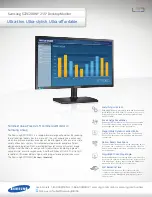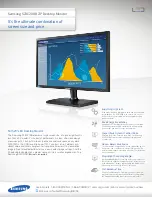
Intel® Xeon® Processor 5600 Series
20
Specification Update, March 2010
did occur in V86 mode, the exception may be directed to the general-protection
exception handler.
Status:
For the steppings affected, see the
BD7.
Incorrect Address Computed For Last Byte of FXSAVE/FXRSTOR
Image Leads to Partial Memory Update
Problem:
A partial memory state save of the 512-byte FXSAVE image or a partial memory state
restore of the FXRSTOR image may occur if a memory address exceeds the 64 KB limit
while the processor is operating in 16-bit mode or if a memory address exceeds the
4 GB limit while the processor is operating in 32-bit mode.
Implication:
FXSAVE/FXRSTOR will incur a #GP fault due to the memory limit violation as expected
but the memory state may be only partially saved or restored.
Workaround:
Software should avoid memory accesses that wrap around the respective 16-bit and
32-bit mode memory limits.
Status:
For the steppings affected, see the
BD8.
Values for LBR/BTS/BTM will be Incorrect after an Exit from SMM
Problem:
After a return from SMM (System Management Mode), the CPU will incorrectly update
the LBR (Last Branch Record) and the BTS (Branch Trace Store), hence rendering their
data invalid. The corresponding data if sent out as a BTM on the system bus will also be
incorrect.
Note: This issue would only occur when one of the 3 above mentioned debug support
facilities are used.
Implication:
The value of the LBR, BTS, and BTM immediately after an RSM operation should not be
used.
Workaround:
None identified
Status:
For the steppings affected, see the
BD9.
Single Step Interrupts with Floating Point Exception Pending May Be
Mishandled
Problem:
In certain circumstances, when a floating point exception (#MF) is pending during
single-step execution, processing of the single-step debug exception (#DB) may be
mishandled.
Implication:
When this erratum occurs, #DB will be incorrectly handled as follows:
• #DB is signaled before the pending higher priority #MF (Interrupt 16)
• #DB is generated twice on the same instruction
Workaround:
None identified.
Status:
For the steppings affected, see the
BD10.
Fault on ENTER Instruction May Result in Unexpected Values on Stack
Frame
Problem:
The ENTER instruction is used to create a procedure stack frame. Due to this erratum,
if execution of the ENTER instruction results in a fault, the dynamic storage area of the
resultant stack frame may contain unexpected values (that is, residual stack data as a
result of processing the fault).
Implication:
Data in the created stack frame may be altered following a fault on the ENTER
instruction. Please refer to "Procedure Calls For Block-Structured Languages" in














































